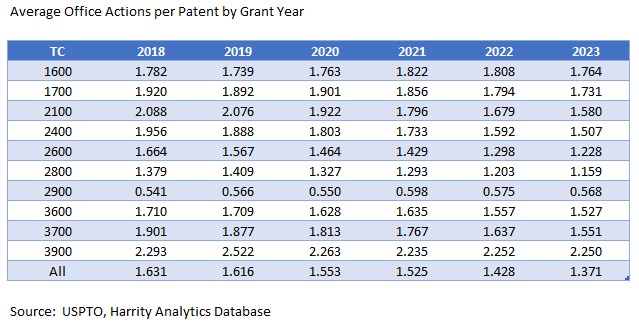Trends and Implications of Decreasing Average Office Actions Per Patent at the USPTO
By Rocky Berndsen, Head of Analytics
The United States Patent and Trademark Office (USPTO) has been observing a notable trend over the past six years that could have significant implications for patent applicants and the patenting process at large. Data from 2018 through 2023 shows that the average number of office actions per patent—a metric that indicates the average number of communications between the patent examiner and the applicant before a patent is either granted or the application is abandoned—has been consistently decreasing across various technology centers (TCs).
Analyzing the Numbers
In 2018, the USPTO’s overall average stood at 1.631 office actions per patent. As of 2023, this number has dipped to 1.371, marking a significant reduction. This decrease is not isolated to a specific sector but is across the board, including high-volume TCs such as 2100 (covering Computer Architecture, Software, and Information Security), which saw a drop from 2.088 to 1.580, and 3700 (covering Mechanical Engineering, Manufacturing, and Products), which went from 1.901 to 1.551.
Shorter Time to Obtain Patents
A primary implication of this trend is a likely acceleration in the patent granting process. With fewer office actions required, the back-and-forth between the USPTO and patent applicants is reduced, potentially leading to a more streamlined examination process. For inventors and companies, this means a faster path to securing patent rights, which can be crucial for maintaining competitive edges in fast-moving industries.
Lower Costs for Applicants
Each office action typically incurs additional costs for applicants, including attorney fees and potential amendment requirements. A reduction in the average number of office actions can thus translate into lower overall costs for obtaining a patent. This could be particularly beneficial for individual inventors and small businesses for whom cost is a major barrier to securing patent protection.
Implications for Patent Quality
However, while fewer office actions suggest a more efficient process, there could be concerns about the thoroughness of patent examinations and the potential impact on patent quality. The USPTO must balance the efficiency of the examination process with the need to maintain high standards for patentability, ensuring that only novel, non-obvious, and useful inventions are granted patent rights.
Impact on Patent Litigation
A decrease in office actions might also influence patent litigation. Patents that undergo fewer office actions could be perceived as less scrutinized, potentially affecting their defensibility in court. Conversely, this trend might result in patents that are more solid due to a more focused examination process, leading to less ambiguity and fewer grounds for litigation.
Enhanced Predictability for Planning
For businesses and investors, a predictable patent examination timeline facilitates better strategic planning and resource allocation. If the trend of decreasing office actions continues, it may enable more precise forecasting of patent portfolios and related business activities.
In conclusion, the downward trend in the average number of office actions per patent at the USPTO is a positive signal for applicants looking for a quicker and less costly patenting process. However, it’s imperative that this efficiency does not compromise the quality of granted patents—a balance the USPTO is undoubtedly striving to achieve. As we watch this trend continue, the patent ecosystem may need to adapt to the evolving dynamics of patent prosecution and enforcement.
Get in Touch for Insights on USPTO Data
If the information above has sparked your curiosity or if you have specific queries about USPTO data and trends, we invite you to reach out. Understanding the intricacies of patent data can provide valuable insights for your patent strategy and decision-making process. By filling out our contact form, you’ll connect with experts who can delve deeper into the data, provide personalized analysis, and help you gain insight from USPTO data.

